I recorded an eight-part video series explaining:
What is Base Training?
What is General Capacity?
What is the difference between Health and Metabolic Fitness?
Where should I target my Green Zone Training?
How much should I do?
What should I expect?
What’s the difference between swim, bike and run?
What nutritional strategy should I follow?
What about Red Zone training?
20-30 years ago, we knew that training around aerobic threshold worked.1
Today, we know more about the “why” behind the mechanism for improving mitochondrial fitness.2
Use the footnotes to access more on the “why.”
In this article, we focus on the how.
Health vs Fitness
If we want to be fit then we need to move more, and more often, than our governments and doctors recommend.
An average of 12 hours a week is a good starting point.3
To assess mitochondrial fitness, I use lactate testing.4
The top red line is from my first bike test when I returned to structured training.
The test shows a lack of mitochondrial fitness.
As soon as I started increasing my work rate (measured in watts), my lactate started rising. This is called a Linear lactate profile.
Further into the test, at 30-40 beats below max, the effort felt moderate but my lactate was elevated into my Tempo Zone (Zone 3 and 4 in common North American usage).
This elevated lactate, a sign of poor metabolic fitness, showed itself via post-workout fatigue and hunger.
Targeting Metabolic Gains
The question we need to answer…
At what power/pace/effort… will my lactate start to rise?
We answer this question so we can aim our training at, or under, this point.
Bike Test Results:
It’s clear that lactate starts to rise after the 160w step.
The first material increase in lactate happens at 180w.
So the first lactate threshold in the test (above) is occurring just after 160w.
My maximum heart rate on the 160w step was 103 bpm. This is more than 60 beats below max.5
Bike Training Prescription:
Don’t rev the engine. Keep the power under 200w. This meant I had to ride mostly indoors.
Sit in the range of 160w-180w range.
Expect an average of ~165w, right around LT1, the first lactate threshold.
For You => don’t spike into the 2mmol zone, aim for an even effort that will result in a ride average around LT1.
Run Test Results:
There is no easy zone for running.
Lactate pops as soon as I start running and, quickly, it transitions to a Tempo workout.
All running, at any speed, is metabolically stressful.
This is a common profile and why we should use the bike as our primary tool for improving metabolic fitness.
Run Training Prescription:
Run as easy as possible.
Regardless of heart rate, assume all running is stressful.
Focus on short, frequent runs.
Keep the runs flat.
How Much Volume To Move The Needle
How do we earn the ability to train more intensely?
Hundreds of well-targeted Green Zone hours.
The amount of work required will not be tolerated if it is solely run focused. Using the bike gives us a well-tolerated exercise option.
Think about 90 minute blocks of continuous aerobic training (targeted as above).
Make sure you have two back-to-back easy days in every week.
That leaves 5 training days for your week. These duration targets should be interpreted based on current capacity.
Two maintenance days (90 minutes each)
Two loading days (2-3 hours each)
One long day (3-6 hours)
If you need more recovery then:
Take extra easy days.
Reduce endurance intensity targets - go even easier.
This structure gives 10-15 hours of training in the core training week.6
At the beginning, you are unlikely to have capacity for Red Zone training. That is OK. Race specific work will come later.
All your energy, and recovery, should be focused on:
Racking up the Green Zone Volume
Quickness Training - skill-based, short duration speed (such as strides)7
Intensity Mix
Don’t Trade Volume For Intensity
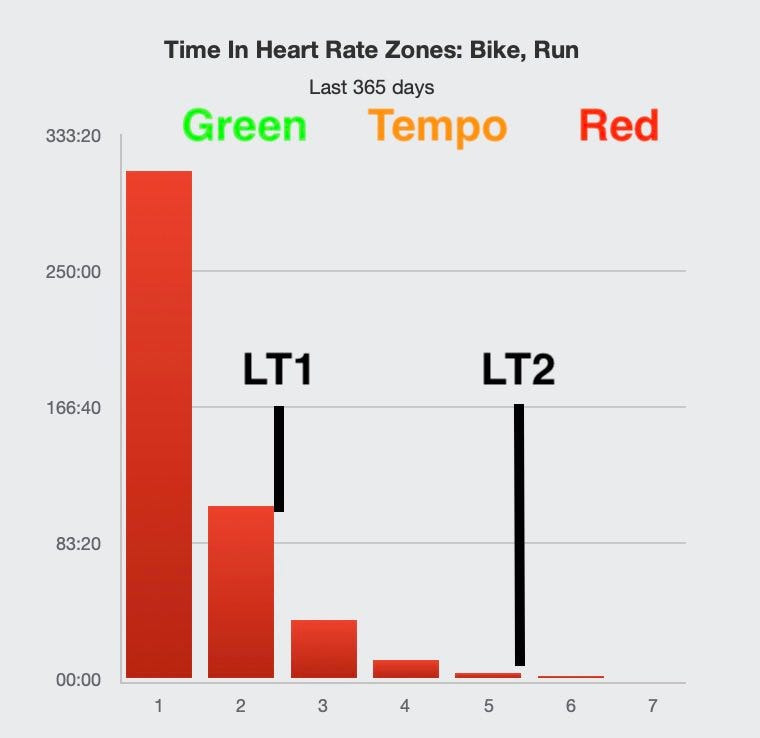
For best results, almost all of your time is going to end up BELOW the first lactate threshold.
Resist the urge to push heart rate up early.
Use long warm-ups.
Enjoy gradual cool downs.
Log the hours.
Reducing relative intensity on the bike is straightforward. This is not the case with other sports.
For example, swim training was internally stressful for me last year.
Strength training is not “easy aerobic,” at any heart rate.
Running training, I had no easy zone.
Think about the overall mix in YOUR week. The true internal stress is likely to be different than what our heart rate tells us.
Don’t fall into the trap of thinking you need high intensity within your aerobic training. You might be getting it elsewhere in your program.
Running
Swimming
Rucking
Rowing
Strength Training
These exercise modes can have internal stress above what our heart rate indicates.
Building Swim Metabolic Fitness
Swim fitness shows late on race day.
As a Multisport athlete, the goal is faster to the finish line, not necessarily faster out of the water.
The water is the best place to save energy.
The land is the most effective place to apply energy.
Reality Check Your Swim Program:
What are your total weekly swimming minutes?
How many minutes do you spend swimming on your longest weekly workout?
Actual swimming for the above.
Not time in the water.
Not time at the pool.
When we look at actual swim time, it’s often lacking.
How can we get more out of our limited time?
Get our weekly long swim as close as possible to 90 minutes, of swimming.
Improve our efficiency in the water.8
Improve technique - 1-on-1 expert coaching with video analysis.
Improve low-end fitness - work the LOW to MODERATE end of the range. If you do all your swimming in a group then I promise you are working too hard. Prove you have an aerobic range (see video above) before adding intensity to your program.
Nutrition for Metabolic Gains
Key things:
If we are training at the low end of our aerobic profile…
For durations under two hours…
Then real food and water will do the trick.
Resist the urge to pour liquid sugar down the throat. You may find you are gaining fat, while adding training volume.
Save the sports nutrition for your longer days. Even then, break up your longer days so you have the ability to fuel with real food choices. I eat all macros (protein, fat & carbohydrate) across my longer days.
The video walks you through my best advice for nutrition. It’s all hosted here.
When we push volume:
Training performance comes first.
Sports nutrition product usage increases.
A slight increase in body weight is normal, and to be expected.
Stable weight is a hallmark of effective nutrition.
Timelines & Tips
It’s going to take a while.
For me, it took a year of consistent training before I felt things shifting on my long days and overall volume tolerance.
Now we look at the lower red line.
Long baseline showing a wide Green Zone.
12 months between the red lines.
Our job is to PERSIST until the protocol starts to work.
Make no decisions until you have been doing the plan for 500 days.
Bike Test:
The test protocol is now, effectively, a long warm-up.
60 minutes of cycling before lactate pops.
Heart rate at LT1 is now higher.
The work rate of “Easy Pace” has increased.9
While it feels like you will be “going easy forever,” that is not the case.
As metabolic fitness develops, our Easy Pace gets faster and faster.
Additionally, volume is better and better tolerated.
So more work can be done.
Run Test:
Different from the first run test (top of this article), lactate drops when I start running. This is what we want to see.
Lactate stays low across the early part of the test.
The top of Easy Pace now requires some effort.
Easy pace no longer feels easy.
Further testing tips are in the video (below) as well as my lactate testing presentation.
Summary & Conclusions
My shift took a year.
The only way to discover how long your shift will take is to do the work.
With your plan:
Build Your Protocol so you get enough work to generate the adaptation.
Speed the Adaptation with superior recovery, not relative intensity:
Sleep
Two back-to-back easy days every week
Focus on Compound Load:
Stack the weeks, months and seasons.
Resist the urge to constantly push short-term load.
Keep What Works.
Notice & Remove Errors.
Back To Table of Contents
Defined as the first material uptick in lactate (LT1/LTP1/AeT).
Readers interested in the latest on mitochondrial fitness should start by listening to Ińigo San Millán on The Proof podcast (show notes & references). Additional podcast links, and my associated notes, can be found here.
The Building Blocks of Lifelong Athleticism provides you with a template for your training week. Additional resources are in The Basic Week Series written by John Hellemans and me.
A full explanation of the lactate testing protocol can be found HERE on my YouTube Channel.
To get a better look at heart rate response use the protocols in The Importance of Submax Benchmarking. Indoor step testing will see a reduced heart rate response, as compared to steady-state outdoor efforts.
The Microcycle section of Better Load Management lets you dig deeper on structuring your week.
Just a hint of Quickness. Long recoveries, only a few intervals. Maintain your focus on building General Capacity.
See Benchmarking Your Swim (article with embedded video) to assess your current efficiency in the water.
See my video, How Your Zones Change As Fitness Improves.

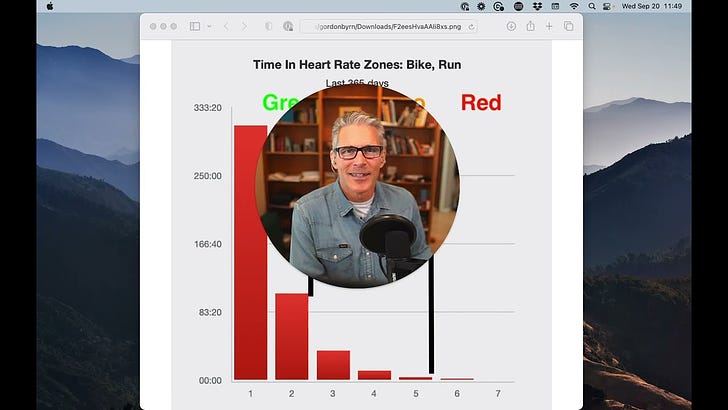


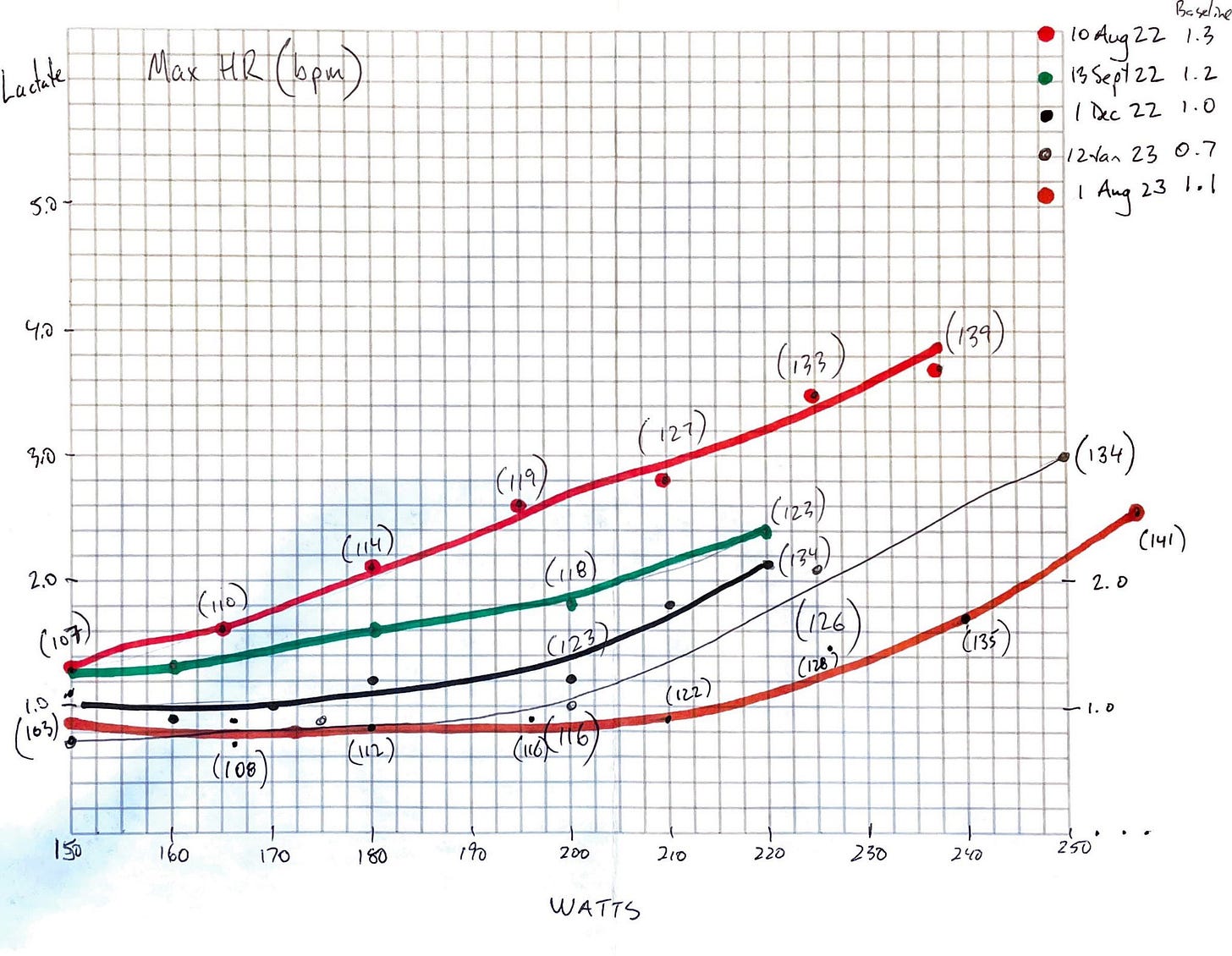
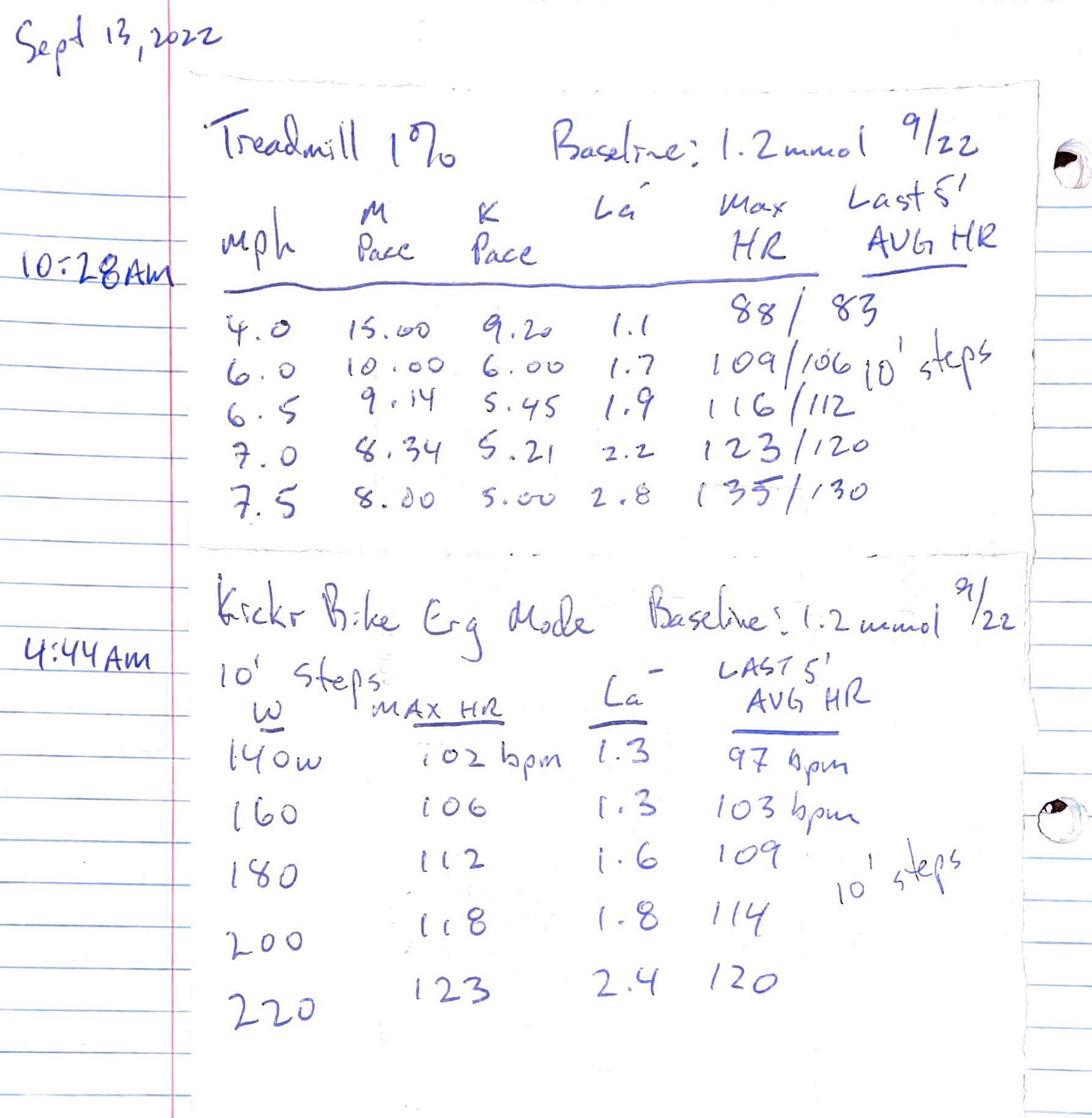
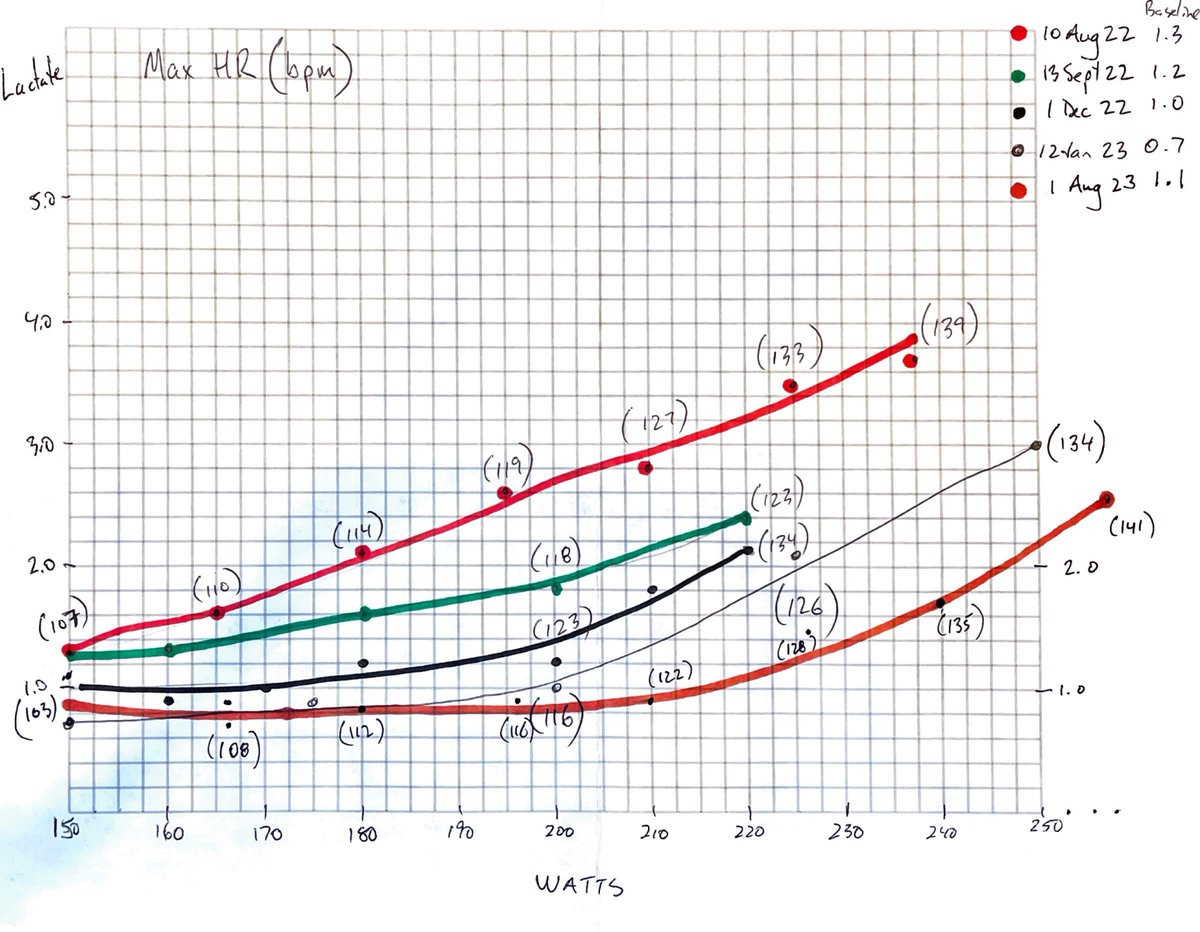

Thanks, Gordo. That makes so much sense. No reason to trash quads or patellar tendons.
Hi Gordo,
Q1: For runners, besides the bike, what do you think of hiking in hilly terrain or XC Skiing as lower impact ways of logging volume, especially for some of the bigger days (2 - 6 hours)? Heart rate average near but below LT1 and capped to be no more than 5 BPM over LT1 (some trails have brief pitches).
Using these HR caps I can tolerate long hikes without post-hike fatigue or soreness. I configure the iSmoothRun app on my watch to audibly call out shifts in heart rate zones. I did a 5 day traverse recently (with a near-zero day on day 3) as a DIY training camp recently
Q2: Any thoughts in choosing OR avoiding terrain with lots of 18-24” rocks in the way (ie, lots of step-ups and step-downs)? A bit of strength WO as part of the hiking.
Thanks for any thoughts